![]()
![]()
![]()
Use LEFT and RIGHT arrow keys to navigate between flashcards;
Use UP and DOWN arrow keys to flip the card;
H to show hint;
A reads text to speech;
9 Cards in this Set
- Front
- Back
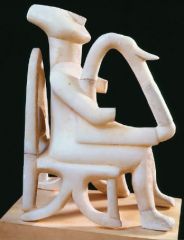
|
Name/ title: Male Lyre Player, Cycladic Date: 2600 BCE Period: Cycladic Period Materials/ techniques: Marble; subtractive technique (carving/ sanding). Artist: Unknown; origin: Keros. Patron: Greek god Apollo. Function: Unclear, but could be to play for the deceased in their afterlife and, thus, for eternity. The lyre is prominent due to its pointed figure. Context: Perhaps placed in tombs to represent a music player; importantly, the instrument is the most outstanding part, probably because it is a precious item. Descriptive terms: Smooth, simple, restful, solid, natural, light. Ideas relevant to the work of art: This piece was discovered along with a female figure in a female grave; instead of representing playing to a deceased image, they may be playing to a spirit. It may also represent Apollo, a Greek god whose representational animal was the swan. |
|
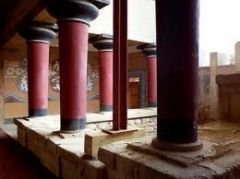
|
Name/ title: Palace of Knossos, Minoan Date: 1600 BCE Period: Minoan Period Materials/ techniques: Stone; additive technique (building/ stacking); subtractive structure (sculpting/ carving) Architect: Unknown. Patron: King Minos Function: To serve as a sort of home for a king named Minos. Has two long corridors and is the origin of the labyrinth: "labrys" means "double-ax." Context: In Theseus, this labyrinth place is what inspired the home of the Minotaur which the Greek hero defeated in his sleep. Descriptive terms: Detailed, heavy, solid, tactile, harmonious, strong/ bold, consistent, balanced. Ideas relevant to the work of art: The architecture is unique in that the ccolumns are wider and larger at the top where the capital is than at the bottom, giving a sort of reversed sense. |
|
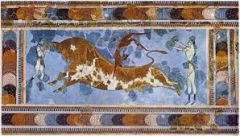
|
Name/ title: Bull-leaping fresco, Minoan; Toreador Fresco Date: 1450 BCE Period: Minoan Materials/ techniques: Dry Fresco; painted technique (additive); relief form. Artist: Unknown. Patron: Unknown; a king or queen. Function: To give an image of a sporting event that may have been popular, valued, or a tradition in those times. Context: Likely placed on a wall; notably, it is mounted with a thick border around it, similar to other Minoan pieces like a sarcophagus. Descriptive terms: Smooth, detailed, blended (colors), tactile, solid, weighty, flowing, horizontal, detailed, linear. Ideas relevant to the work of art: The body is not quite proportional; the waists are very small and the body is quite elongated; it is not exactly hieratic scale, but the person on the left is made smaller to make if evident that she is not standing directly in front of the bull, as the woman on the right is standing directly behind it. Gender is identified through differing skin tones here. |
|
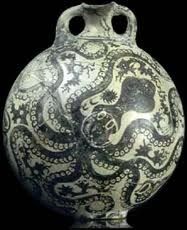
|
Name/ title: Octopus jar, Minoan Date: 1500 BCE Period: Minoan Materials/ techniques: Clay; painted (additive technique). Artist: Unknown. Patron: Unknown; tribute to a king. Function: To identify the anatomy and symbolism of a squid in this culture; to serve as a poignant ornament (moving or special). Context: Perhaps placed in a tomb as a sign of the afterlife or placed in a home as a form of protection; unclear because it is something that is more display-oriented than to be hidden. Descriptive terms: Smooth, detailed, centrally focused, solid, weighty, smooth, blended (colors), bold, harmonious, flowing. Ideas relevant to the work of art: The octopus seems to have been painted to seem like it is clinging the jar, almost as if it were a relief/ three-dimensional to give it a more realistic feeling. |
|
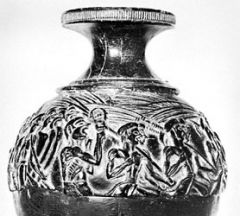
|
Name/ title: Harvester Vase Date: 1500 BCE Period: Minoan Materials/ techniques: Steatite; relief sculpture; subtractive technique (carving). Artist: Unknown. Patron: Unknown. Function: To serve as funerary art, perhaps in a tomb of sorts or in/ beside a sarcophagus. Context: It told the story of the harvester people who had to work day and night; likely a piece meant for the common people as a sort of legacy of their work. Descriptive terms: Rough, blended (shades), detailed, horizontal, strong/ bold, rigid, flowing, off center, externally oriented, linear. Ideas relevant to the work of art: The art piece may lack color due to the fact that it is a funerary piece that does not depict a happy time; it instead illustrates constant hard work, which may have been difficult or tedious at times; in addition, the people seem to be one with the background and blend in with it and each other, thus making for a cramped-looking piece from afar. |
|
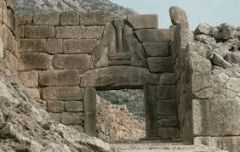
|
Name/ title: Lions Gate, Mycenaean Date: 1300 BCE Period: Mycenaean Materials/ techniques: Limestone, relief panel; additive structure (building/ stacking). Architect: Unknown. Patron: Unknown; a king/ ruler. Function: To protect a city/ town/ palace from outside danger; a sort of protecting buffer or border. Context: Placed on the outside of the city in order to signify a sort of boundary that cannot be entered easily. Descriptive terms: Linear, off center, natural, rigid, stacked, clear, harsh, vertical, consistent, harmonized with surroundings, repetitive. Ideas relevant to the work of art: Instead of having large statues at the side of the gate, it is kept simple, but still offers a fair warning. The wolf-like creatures at the top are howling as if they are, perhaps, searching for prey. The animals look fearful, which is a sign that enemies should keep out. |
|
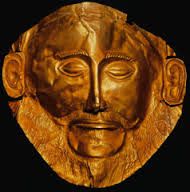
|
Name/ title: Funerary Mask, Mycenaean Date: 1500 BCE Period: Mycenaean Materials/ techniques: Beaten gold; subtractive structure (beat in). Artist: Unknown. Patron: Agamemnon (possibly a king). Function: Originally, it was believed that it resembled the purpose of Tutankhamun's funerary mask, though more "primitive" in structure. Context: It was originally believed to have served as a mask for Agamemnon, but it seems unlikely since it was created before this man, maybe a king, was even born. Descriptive terms: Rigid, natural (material, color- single); rough, weighty, balanced, centrally focused, static, closed, detailed. Ideas relevant to the work of art: This piece represents an early attempt at recreating the human face not on a flat canvas, but on a three-dimensional structure. The status and wealth of the man depicted (if it was any specific man at all) is demonstrated by the utilization of gold, the great detail, and the fact that such a grand piece was created for him. |
|
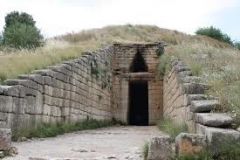
|
Date/ title: Treasury of Atreus, Mycenaean Date: 1300 BCE Period: Mycenaean Materials/ techniques: Stone block; additive technique (building/ stacking). Artist: Unknown. Patron: Atreus. Function: Meant to serve as a tomb for a king named Agamemnon; not exactly an example of a treasury, as the name implies. Context: Carved into a hillside, as typical of tombs in this specific age; it blends in with the hill because the stone bricks align with the increasing height of the dirt mound. Descriptive terms: Horizontal, consistent, repetitive (blocks), massive, heavy, solid, geometric, natural, symmetrical, harmonized with surroundings, flowing, centrally focused. Ideas relevant to the work of art: This tomb may have been created in this manner in order to emphasize a harmony with nature/ a person's surroundings and a respect for them even in one's afterlife. |
|
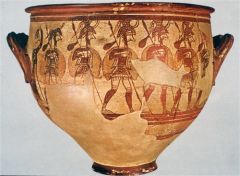
|
Date/ title: Warrior Vase, Mycenaean Date: 1200 BCE Period: Mycenaean Materials/ techniques: Dried clay; subtractive technique (sculpting; removing inner portion); additive technique (painting). Artist: Unknown. Patron: Soldiers and their significant other women. Function: To exhibit the bravery of men who go out to battle and the support of the families who rally behind them. Context: May have been placed in a tomb or a home in order to demonstrate respect; it shows the bravery and relentlessness of dedicated fighters for what they believe in or what they feel obliged to complete. Descriptive terms: Smooth, detailed, blended, solid, weighty, static, off center, linear, horizontal, consistent, repetitive, light, externally oriented. Ideas relevant tot he work of art: It is important to notice that they are all walking symmetrically with one another; this demonstrates unity and a uniform matter associated with marching. It also demonstrates courage as none hesitates to move forward. Women are given credit in this piece through their adamant support o their significant other or family member on this fearful quest. |

